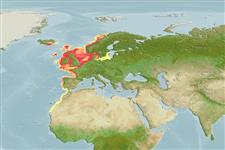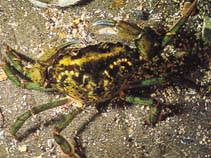Carcinus maenas (Linnaeus, 1758)
Green crab| Native range | All suitable habitat | Point map | Year 2050 |

|
| This map was computer-generated and has not yet been reviewed. |
| Carcinus maenas AquaMaps Data sources: GBIF OBIS |
Classification / Names Common names | Synonyms | CoL | ITIS | WoRMS
Malacostraca | Decapoda | Carcinidae
Environment: milieu / climate zone / depth range / distribution range Ecology
Benthic; brackish; depth range 0 - 200 m (Ref. 2779), usually 0 - 6 m (Ref. 114208). Subtropical; -1°C - 22°C (Ref. 114208), preferred 12°C (Ref. 107945); 70°N - 22°N, 20°W - 19°E (Ref. 114232)
Distribution Countries | FAO areas | Ecosystems | Occurrences | Introductions
Eastern Atlantic: From Great Britain north to Iceland, the North Sea and Norway, south to Portugal and Spain to Mauritania. Introduced and established in North America, South Africa (Cape Town), and Australia. Introduced but not established in Panama, Brazil, Pakistan, Sri Lanka, Madagascar, Myanmar, Japan and Hawaii. Subtropical to polar.
Length at first maturity / Size / Weight / Age
Maturity: Lm ?, range 1 - 4.5 cm Max length : 6.0 cm CL male/unsexed; (Ref. 435); common length : 4.0 cm CL male/unsexed; (Ref. 435); max. reported age: 7 years (Ref. 128193)
Usually found in eelgrass beds (Ref. 128717). Maximum carapace width: 7.7 cm; commonly 5 cm wide. Inhabits shallow water from the intertidal area down to 200 m. Lives under stones, on muddy or muddy sand bottoms, or hard bottom, etc. Also inhabits brackish lagoons (Ref. 2779), and eelgrass beds (Ref. 128717).
Life cycle and mating behavior Maturity | Reproduction | Spawning | Eggs | Fecundity | Larvae
Members of the order Decapoda are mostly gonochoric. Mating behavior: Precopulatory courtship ritual is common (through olfactory and tactile cues); usually indirect sperm transfer (Ref. 833). Berried females migrate from littoral areas to more saline and deeper water (8-10 m) until hatching of eggs; afterwhich, they go back to moult and copulate (Ref. 128197). Larger females can breed twice or thrice annually (Ref. 128203).
Main reference
References | Coordinator | Collaborators
Fischer, W., G. Bianchi and W.B. Scott (eds.). 1981. (Ref. 435)
IUCN Red List Status (Ref. 130435)
CITES status (Ref. 108899)
Not Evaluated
CMS (Ref. 116361)
Not Evaluated
Threat to humans
Human uses
Fisheries: commercial
FAO - Fisheries: landings | FishSource | Sea Around Us
Tools
More information
Internet sources
BHL | BOLD Systems | CISTI | DiscoverLife | FAO(Fisheries: ; publication : search) | Fishipedia | GenBank (genome, nucleotide) | GloBI | Gomexsi | Google Books | Google Scholar | Google | PubMed | Tree of Life | Wikipedia (Go, Search) | Zoological Record
Estimates based on models
Preferred temperature
(Ref. 115969): 7 - 12.7, mean 9.6 (based on 453 cells).
Nutrients: Calcium = 109 [35, 184] mg/100g; Iron = 1.59 [1.21, 1.97] mg/100g; Protein = 20.2 [19.2, 21.3] %; Omega3 = 0.285 [0.185, 0.386] g/100g; Selenium = 48.3 [-31.7, 128.3] μg/100g; VitaminA = 0 μg/100g; Zinc = 1.79 [1.17, 2.40] mg/100g (wet weight).



